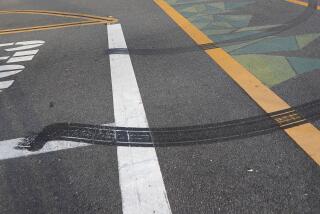A shift in gang tactics means drive-bys are giving way to walk-ups, observers say

Ricardo Nunez was trimming a tree outside his Echo Park home on a Sunday morning last month when a white truck pulled up and a person inside opened fire, killing the 35-year-old father.
Ray Martinez, the LAPD detective investigating the case, is seeing fewer such fatal drive-by shootings. When Martinez goes behind the yellow tape, he’s more commonly working on cases where a gunman has walked straight up to the victim — a walk-up shooting.
As gang culture has become less overt, the killings have become more targeted — and at the same time more chilling.
“They get to see the whole reaction,” Martinez said. “It seems more daring.”
Jorja Leap, a UCLA anthropologist who studies gang culture, agreed. “In a walk-up, you see who you’re killing,” Leap said. “You’re going to listen to what they say as you shoot them.”
Fatal drive-by shooting statistics were not publicly available from the LAPD, and there are no recent national statistics. But Leap sees a shift in how gangs operate.
Once known for street intimidation, gang colors and the violence made famous in the movie “Boyz n the Hood,” over the years black and Latino gangs have had truces to stop drive-by shootings. In 1993, the Mexican Mafia prison gang — known by police as “La Eme” — ordered thousands of Latino gang members to halt them.
In the 21st century, Leap said, gangs have become more strategic and focus more on criminal business enterprise — where the most money can be made.
“Drive-bys just don’t work as well,” she said. “When you do a drive-by, that’s where you have the greatest sense of inaccuracy.
“Gangs want to survive,” she added, “and gangs want to put their work in.”
A high-profile shooting can taint their business dealings.
“Nobody is going to buy dope from them; everybody is going to stay away from them when the police are all over them,” Martinez said.
He pointed to a 2007 shooting in which a 23-day-old boy was struck and killed after gang members targeted a street vendor who refused to pay a $50 “rent” near MacArthur Park. Luis Garcia was in his stroller when he was shot. The last of seven gang members convicted in the crime was sentenced in 2013 to life in prison without parole.
Eight years later, the area around where Luis Garcia was killed remains dominated by Latino gangs — the largest being 18th Street and Mara Salvatrucha, commonly known as MS-13.
But gang activities have shifted away from violent wars over turf and drugs, said Sgt. Frank Banuelos, a gang supervisor with the Rampart Division, where Nunez was killed. Now they sell fake government documents, conduct robberies or collect taxes on drugs or on goods sold by street vendors.
MS-13 operates what police call “casitas” — after-hours parties where men go to buy drugs and have sex with prostitutes. Still, violence is not completely avoidable: Two people were killed outside a casita in 2013.
Leap, the anthropologist, says gang members want to avoid long prison sentences, so they target each other.
“It’s ultimately a statement about the value of all of their lives,” she said. “Outside lives have more value.”
Still, the days of drive-bys are not over. Last week, two men in a gold sedan opened fire on South Rampart Boulevard, hitting a 57-year-old woman who was shopping for groceries. A gang member was the intended target. The woman, who was shot in the leg, is expected to survive.
Twitter: @nicolesantacruz
More to Read
Start your day right
Sign up for Essential California for news, features and recommendations from the L.A. Times and beyond in your inbox six days a week.
You may occasionally receive promotional content from the Los Angeles Times.







